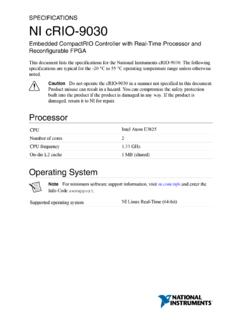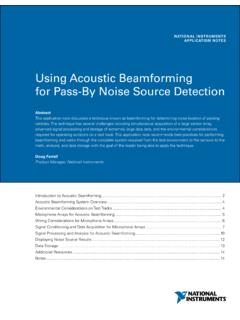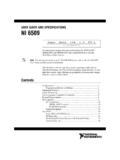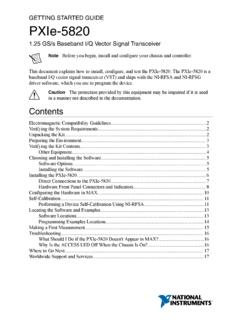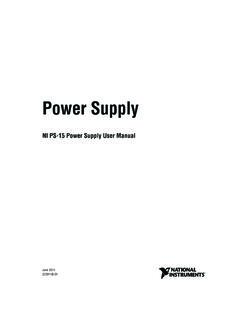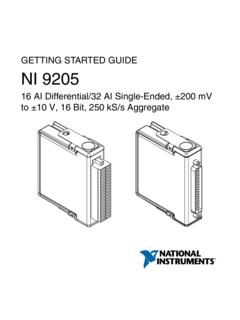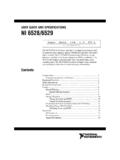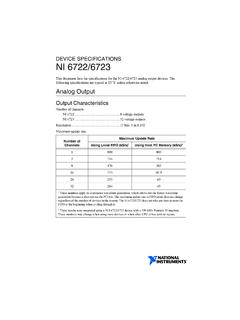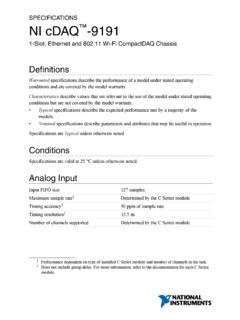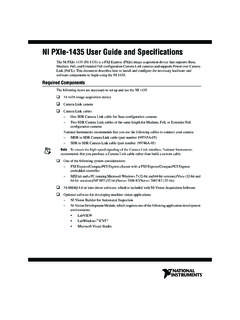Transcription of OPERATING INSTRUCTIONS NI 9853 - National …
1 OPERATING INSTRUCTIONSNI 98532-Port, High-Speed CAN ModuleNI 9853 OPERATING OPERATING INSTRUCTIONS describe how to use the National Instruments (NI) 9853 module. For information about installing, configuring, and programming your system, refer to your system documentation. The ni 9853 module requires the ni 9853 software to be installed. The latest version of the ni 9853 software is located at safety guidelines and specifications in this document are specific to the ni 9853 . The other components in your system may not meet the same safety ratings and specifications. Refer to the documentation for each component in your system to determine the safety ratings and specifications for the entire GuidelinesOperate the ni 9853 only as described in these OPERATING SurfaceThis icon denotes that the component may be hot.
2 Touching this component may result in bodily injury. National Instruments 9853 OPERATING InstructionsSafety Guidelines for Hazardous LocationsThe ni 9853 is suitable for use in Class I, Division 2, Groups A, B, C, D, T4 hazardous locations; Class I, Zone 2, AEx nA II T4 and Ex nA II T4 hazardous locations; and nonhazardous locations only. Follow these guidelines if you are installing the ni 9853 in a potentially explosive environment. Not following these guidelines may result in serious injury or not disconnect I/O-side wires or connectors unless power has been switched off or the area is known to be not remove modules unless power has been switched off or the area is known to be of components may impair suitability for Class I, Division Zone 2 applications, install the CompactRIO system in an enclosure rated to at least IP 54 as defined by IEC 60529 and EN 9853 OPERATING Zone 2 applications, install a protection device between the CAN signals and the ni 9853 CAN pins.
3 The device must prevent the CAN Port-to-COM voltage from exceeding 55 V if there is a transient overvoltage Conditions for Safe Use in EuropeThis equipment has been evaluated as EEx nA II T4 equipment under DEMKO Certificate No. 03 ATEX 0324020X. Each module is marked II 3G and is suitable for use in Zone 2 hazardous the ni 9853 The ni 9853 has two 9-pin male D-Sub connectors that provide connections to a CAN bus. Each port on the ni 9853 has pins for CAN_H and CAN_L, to which you connect the CAN bus signals. These signals should be connected using twisted-pair port has two common pins (COM) that are internally connected to the isolated reference of the module and serve as the reference ground for CAN_H and CAN_L. You can connect the CAN bus reference ground (sometimes referred to as CAN_V ) to National Instruments 9853 OPERATING Instructionsone or both of the COM pins.
4 Each port also has an optional shield pin, SHLD, that can be connected to a shielded CAN cable. Connecting SHLD may improve signal integrity and EMC performance in a noisy of the ni 9853 is internally powered, and therefore requires no external power supply. CAN1 requires an external power supply of +8 to +25 V to operate. Supply power to the VSUP pin of CAN1 from the CAN CAN0 of the ni 9853 does not require an external power supply to operate, it can be connected to a powered CAN bus without being for CAN0 and CAN1 of the ni 9853 are listed in Table 1 and Table 4 lists recommended termination resistor 9853 OPERATING Table 1. Pin Assignments for CAN0 ConnectorPinSignal1No Connection (NC)2 CAN_L3 COM4NC5 SHLD6 COM7 CAN_H8NC9NC678912345 National Instruments 9853 OPERATING INSTRUCTIONS Table 2.
5 Pin Assignments for CAN1 ConnectorPinSignal1No Connection (NC)2 CAN_L3 COM4NC5 SHLD6 COM7 CAN_H8NC9 VSUP678912345NI 9853 OPERATING Bus Topology and TerminationA CAN bus consists of two or more CAN nodes cabled together. The CAN_H and CAN_L pins of each node are connected to the main CAN bus cable through a short connection known as a stub. The pair of signal wires, CAN_H and CAN_L constitutes a transmission line. If the transmission line is not terminated, each signal change on the bus causes reflections that may cause communication errors. Because the CAN bus is bidirectional, both ends of the cable must be terminated. However, this requirement does not mean that every node on the bus should have a termination resistor only the nodes at the end of the cable should have termination 1 shows a simplified diagram of a CAN bus with multiple CAN nodes, and proper termination resistor (Rt) locations.
6 National Instruments 9853 OPERATING InstructionsFigure 1. CAN Bus Topology and Termination Resistor LocationsCANNodeCANNodeCANNodeRtRtCANNod eCAN_HCAN_LCAN_HCAN_LCAN_HCAN_LCAN_HCAN_ LBus Cable LengthStubLengthNI 9853 OPERATING a CAN Bus to the ni 9853 Each port of the ni 9853 can be connected to any location on a CAN bus. Figure 2 shows one example of the connection of CAN0 of the ni 9853 directly to one CAN node, and CAN1 directly to another CAN node. CAN1 requires an external power supply on the CAN bus. National Instruments 9853 OPERATING InstructionsFigure 2. Connecting Both Ports of the ni 9853 to CAN BusesCAN1 CAN DeviceCAN0NI 9853 RtCANC able(With OptionalShield)(SHLD)CAN_HCAN_LVsupCOMRt (SHLD)CAN_HCAN_LVsupCOMCAN DeviceRtCANC able(With OptionalShield)(SHLD)CAN_HCAN_LVsupCOMRt (SHLD)CAN_HCAN_LVsupCOM+ ExternalPowerSupplyNI 9853 OPERATING Requirements for ni 9853 This section deals with cabling specifications, termination resistors, cable lengths, and the number of CAN nodes that can exist in a SpecificationsCables should meet the physical medium requirements specified inISO 11898, shown in Table 3.
7 Belden cable (3084A) meets all of those requirements, and should be suitable for most 3. ISO 11898 Specifications for Characteristics of a CAN_H and CAN_L Pair of WiresCharacteristicVa l u eImpedance95 minimum, 120 nominal, 140 maximumLength-related resistance70 m /m nominalSpecific line delay5 ns/m nominal National Instruments 9853 OPERATING InstructionsTermination ResistorsThe termination resistors (Rt) should match the nominal impedance of the CAN cable, and therefore comply with the values in Table LengthsThe allowable cable length is affected by the characteristics of the cabling and the desired bit transmission rates. Detailed cable length recommendations can be found in the ISO 11898, CiA DS 102, and DeviceNet 11898 specifies 40 m total cable length with a maximum stub length of m for a bit rate of 1 Mb/s.
8 The ISO 11898 specification says that significantly longer cable lengths may be allowed at lower bit rates, but each node should be analyzed for signal integrity 4. Termination Resistor SpecificationCharacteristicVa l u eConditionTermination resistor, Rt100 min, 120 nominal, 130 maxMinimum power dissipation: 220 mWNI 9853 OPERATING of CAN NodesThe maximum number of nodes depends on the electrical characteristics of the nodes on the network. If all of the nodes meet the requirements of ISO 11898, at least 30 nodes may be connected to the bus. Higher numbers of nodes may be connected if the electrical characteristics of the nodes do not degrade signal quality below ISO 11898 signal level electrical characteristics of the ni 9853 allow at least 110 CAN ports on a 9853 Hardware OverviewThe ni 9853 has two full-featured, independent CAN ports that are isolated from each other, and from the other modules in the system.
9 Each port of the ni 9853 has a Philips SJA1000 CAN controller that is CAN and fully supports both 11-bit and 29-bit identifiers. Each port also has a Philips TJA1041 High-Speed CAN transceiver that is fully compatible with the ISO 11898 standard and supports baud rates up to 1 Mbps. National Instruments 9853 OPERATING InstructionsFigure 3. ni 9853 Hardware OverviewRx Tx CAN Transceiver +5 V_ISO +5 V GND COM CAN_H CAN_L +5 V Reg Rx Tx Ext Pwr Supply CAN Controller Rx Tx CAN Controller CAN_H CAN_L CAN Transceiver Rx Tx COM Vsup CAN0 CAN1+_Iso Pwr ni 9853 OPERATING Mode (CompactRIO Only)You can enable sleep mode for the CompactRIO system in software. In sleep mode, the system consumes less power and may dissipate less heat. Typically, when a system is in sleep mode, you cannot communicate with the modules.
10 Refer to the Specifications section for more information about power consumption and thermal system sleep mode should not be confused with the ni 9853 Transceiver Mode Sleep property, which sets only the CAN port to sleep mode. Refer to the FPGA Module topic in LabVIEW Help for more information on the Transceiver Mode property. National Instruments 9853 OPERATING InstructionsSpecificationsThe following specifications are typical for the range 40 to 70 Cunless otherwise CAN Philips TJA1041 Max baud rate .. 1 MbpsCAN_H, CAN_L bus 27 to +40 VDCS upply voltage range (VSUP)CAN0 .. N/ACAN1 .. +8 to +25 VDCMTBF .. 1,816,913 hours at 25 C; Bellcore Issue 6, Method 1, Case 3, Limited Part Stress MethodNoteContact NI for Bellcore MTBF specifications at other temperatures or for MIL-HDBK-217F 9853 OPERATING RequirementsPower consumption from chassisActive modeTransmitting.
